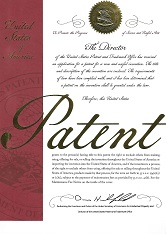Expanded Details on Claims and Functionalities of US Patent No. 11210963 explained.
Key Functional Elements of the Invention:
Automatic Audio-Visual Instructional Apparatus:
Gyroscope Accelerometer Magnetometer Sensors:
Affixed to the person and/or an object controlled by the person.
Physically and computationally independent.
Capture and process 2D or 3D coordinates, orientation, and movement data while the person undertakes an activity.
Data Logging Unit:
Associated with the gyroscope accelerometer magnetometer sensors.
Receives captured data, including processed coordinates, orientation, and movement data from the sensors.
Computer Device:
In communication with the data logging unit.
Comprises a database and a processor.
The database stores the captured data and pre-stored data related to preferred positions and movements.
The processor analyzes and compares the captured data with pre-stored data.
Generates a visual presentation based on the differences and adds audio instructional comments.
Forms an audio-visual teaching presentation with images representing an entire body emulating the preferred movement.
Transceiver Unit:
Communicates with the computer device.
Receives and displays the audio-visual teaching presentation.
Additional Claims and Functionalities:
Bio-Mechanical Sensors: Sensors for Physical, Mechanical, or Object Movement:
Senses various bio-mechanical data relevant to the activity.
Bio-Mechanical Movement Sensors:
Generate bio-mechanical movement data.
Pre-stored data comprises pre-stored movement data.
Audio instructional comments are spoken words or phrases that inform the person.
Automatic Audio-Visual Instructional Apparatus for Emulating Preferred Movement:
Similar structure to the initial description but includes bio-mechanical sensors.
Sensors sense bio-mechanical data while the person undertakes the activity.
The computer device stores and processes both movement and bio-mechanical data.
The presentation includes digitized libraries for comparison and instructional comments.
Types of Bio-Mechanical Data:
Includes weight transference, alignment, grip pressure, load, impact, and physical movement.
MEMS Movement Sensors:
Configured to be attached to or incorporated into clothing worn by the person.
Transceiver Communication:
Communicates via a link to receive captured data and convey it to the computer device.
Receives the audio-visual teaching presentation for display.
Intermediate Processor and Modem:
The transceiver includes an intermediate processor and a modem for data transmission over the communication link.
Display for Presentation:
Configured to receive and display the audio-visual teaching presentation from the transceiver unit.
Details on Bio-Mechanical Movement Sensors:
Similar to claim 13, ensuring sensors generate bio-mechanical movement data, with pre-stored data for comparison and audio comments.
Summary
The patent describes an advanced instructional system using sensors to capture detailed movement data, which is then compared with pre-stored ideal data. The system provides personalized feedback through audio-visual presentations, incorporating scientific data and expert advice. This technology can be broadly applied to enhance training and instruction across various physical activities.
This 2017 invention for a wearable device that provides automatically personalized audio and visual instruction remains highly relevant and innovative in today’s context. Here’s an overall opinion on its significance and potential impact:
Key Strengths and Relevance:
- Personalized Feedback:
The invention’s ability to offer real-time, personalized audio-visual feedback is a major strength. This feature is increasingly important as personalized learning and coaching become more prominent in various fields, including sports, fitness, rehabilitation, and even education. - Integration of Bio-Mechanical Data:
Including bio-mechanical sensors for detailed analysis of physical activities adds a scientific and data-driven dimension to the feedback. This is crucial for precise performance improvement and injury prevention. - Advancements in Wearable Technology:
The use of MEMS sensors and other advanced wearable technologies is in line with current trends. Wearable tech has grown significantly, and the invention was ahead of its time in leveraging these sensors for comprehensive motion analysis. - Applicability Across Multiple Domains:
The broad applicability of the invention—from sports coaching to physical therapy and beyond—makes it versatile. This is particularly valuable as the market for wearable technology continues to expand into various new areas. - Enhanced User Experience:
The combination of visual and auditory feedback enhances the learning experience, making it more engaging and effective. Modern users expect interactive and immersive experiences, which the invention provides.
Current Trends and Potential Improvements:
- Integration with Modern Platforms:
Today, integrating this technology with smartphones, smartwatches, and cloud-based platforms could enhance accessibility and user convenience. Developing an app that works in conjunction with the wearable device would be beneficial. - Artificial Intelligence and Machine Learning:
Leveraging AI and machine learning can further enhance the personalization aspect by continuously learning and adapting to the user’s progress and specific needs. AI could also help in providing more nuanced and advanced feedback. - Health and Wellness Applications:
With the growing emphasis on health and wellness, the invention can be adapted for more personalized health monitoring and fitness coaching, making it a valuable tool in preventive healthcare. - User-Friendly Design:
Ensuring that the wearable sensors are lightweight, comfortable, and unobtrusive is important for user adoption. Advances in material science and design can help achieve this. - Data Privacy and Security:
As with any data-driven device, ensuring robust data privacy and security measures is critical, especially when dealing with personal and potentially sensitive bio-mechanical data.
Conclusion:
The 2017 patent is impressively forward-thinking and aligns well with current technological trends and user needs. It holds significant potential for further development and application in today’s market. By integrating modern advancements and focusing on user-centric design, this invention can continue to be a leading solution in the field of personalized instructional technology
